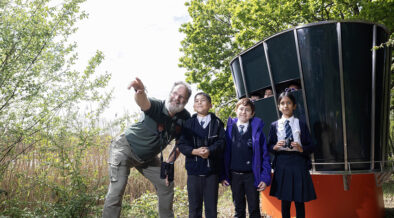
Airport World shines the spotlight on a handful of very different sustainability initiatives across Europe and North America.
Engaging with the local community
London’s Heathrow Airport has unveiled an Air Traffic Control tower shaped bird hide in a local nature reserve in the heart of one of its 13 local nature conservation sites.
The one-of-a-kind bird hide, designed to resemble the airport’s iconic control tower, serves as a camouflaged lookout, allowing visitors to watch a huge range of bird species ‘coming into land’, along with other local wildlife.
According to the UK hub, the tower has been created to raise awareness of Heathrow’s Nature Positive Plan, detailing how the airport will better understand and, where possible, reduce its environmental impacts.
Becky Coffin, Heathrow’s communities and sustainability director, said: “Our work to support nature happens all year round – from introducing cattle to graze habitats in spring, to discovering new-to-science fungi in our woodlands in autumn, and rotational hedgerow management in winter.
“Maintaining and restoring nature is a priority for Heathrow, and we hope this birdwatching experience helps bring our Nature Positive Plan to life and shows travellers that Heathrow is committed to biodiversity, giving them greater confidence in their travel choices.”
Heathrow notes that its commitment to building on its ongoing efforts to protect and actively restore local biodiversity and ecosystems forms part of the airport’s wider Connecting People and Planet sustainability strategy, which includes a £250 million investment from the airport into carbon and sustainability improvements for the 2022-2026 period.
Heathrow manages 170 hectares of land across the 13 biodiversity sites surrounding the airport – equating to 10% of Heathrow’s overall footprint.
Exeter Airport demonstrates potential of hydrogen
Elsewhere in the UK, a pioneering demonstration showcasing how hydrogen can support the decarbonisation of airport ground operations has taken place at Exeter Airport.
In a first of its kind for the UK, the trial saw a TUI Boeing 737 passenger aircraft undergo a turnaround using ground support equipment powered by green hydrogen. The live demonstration involved a hydrogen-powered baggage tug, pushback tug and ground power unit.
The airport believes that it might have been the first time in the world that multiple pieces of hydrogen-powered equipment were simultaneously used for a commercial air transport operational aircraft and using ‘green’ hydrogen from renewable energy sources.
Stephen Wiltshire, managing director of Exeter Airport, noted: “The demonstration shows how hydrogen can be integrated into day-to-day airport operations, with lessons we can share across our airport group and the wider sector.”
The pioneering trial was supported by the UK Civil Aviation Authority’s Hydrogen Challenge programme and held in partnership with TUI, Cranfield University, ULEMCo, MULAG and Boeing.

Shh.. quietly does it Van Nuys Airport
The jet operators that reduced their noise levels at Van Nuys Airport (VNY) in 2024 have been recognised by Los Angeles World Airports (LAWA) in its annual Friendly Flyer Award Program.
“The Fly Friendly Program is an important part of Van Nuys Airport’s overall outreach and sustainability efforts, in which we work to benefit our neighbouring communities through engagement, enrichment, and action,” said Jacob Haik, Van Nuys’ airport manager.
“Together, as part of an ongoing dialogue of community stakeholders, airport tenants, and regulators, we are building a VNY that is responsive to its neighbours and enables economic opportunities in more sustainable ways than ever before.”
The Friendly Flyer Award Program was established in 2012, and recognises jet operators that achieve the highest level of compliance with mandatory noise policies and voluntary noise abatement programmes at VNY.
The 26 winners included the MC Group, Chrysler Aviation, Fly Alliance, Flexjet, Talon Air and Vista America.
“These winners have been instrumental in minimising aircraft noise and play an important role in helping our neighbours maintain their quality of life,” said Crystal Lee, LAWA’s deputy executive director for the airport development group, sustainability, energy, environmental and development services.
“In 2024, these operators reduced their cumulative net VNY night-time jet operations by 21% year-over-year, demonstrating their commitment to flying quieter and friendlier for the benefit of our surrounding communities.”
SJC unveils new sustainability mascot
San José Mineta International Airport celebrated Earth Day by launching a new initiative dedicated to keeping landside areas clean and unveiling a new sustainability mascot.
Clean SJC is a new employee-led initiative dedicated to keeping the airport’s landside areas clean and fostering a culture of environmental responsibility.
The airport notes that it builds on SJC’s recent milestones that include LEED Silver certification of its new Facilities Administration and Fleet Maintenance buildings and upgrade to Level 2 certification in the Airport Carbon Accreditation programme.
Future Clean SJC events will expand to include volunteer creek clean-ups along the Guadalupe River, in partnership with Valley Water and the Creek Connections Action Group, extending SJC’s impact beyond airport grounds.
Earth Day also marked the debut of ‘Perry’ the chick, the airport’s new sustainability champion mascot, inspired by San José’s unofficial bird, the Peregrine Falcon.
Perry joins the flock of seven endearing chicks that have become a favourite among aviation enthusiasts and SJC travellers alike, commemorating the 75th anniversary of the airport’s inaugural commercial flight in February 1949, which arrived carrying two pilots, seven human passengers and 2,550 baby chickens.
“Clean SJC is powered by dedicated staff who are passionate about supporting our community,” enthused SJC’s director of aviation, Mookie Patel. “I am proud of the SJC team for their leadership in sustainability, as we welcome Perry the chick to the airport family.”

Dublin Airport to invest in expanding its onsite solar farm
Dublin Airport has committed to a significant expansion of its on-site solar farm as it wants renewable solar energy to meet more than 20% of its annual electricity needs by 2030.
Operator, daa, made the announcement at the official opening of Phase 1 of Dublin Airport’s solar farm by Minister for Transport Darragh O’Brien TD.
Phase 1 saw the installation of more than 15,000 solar panels by Greenvolt Next, one of Ireland’s leading providers of renewable energy solutions, on a 28-acre site located close to the south runway and visible from the R102.
Now operational, the 9MWp solar farm is expected to generate 7GWh to 9GWh per annum dependent on weather conditions, which is 10% to 13% of Dublin Airport’s annual consumption.
This is sufficient to cover the electricity needs of the entire airfield, with excess electricity contributing to the energy needs of the airport terminals and campus.
The commitment to Phase 2 will see the airport campus further reduce its impact on the national electricity grid as part of a wider pipeline of renewable energy projects.
Subject to planning permission, Phase 2 envisages the staged deployment of an additional 6,000 solar panels by late 2027.
This is sufficient to fully power the baggage systems in T1 and T2 and means a further 4% – 6% of the annual electricity needs of Dublin Airport will come from renewable energy generated on-site.
Vincent Harrison, daa’s chief commercial and development officer, noted: “Investing in solar reduces Dublin Airport’s reliance on the national electricity grid and boosts our onsite energy generation capabilities.
“Continuing to invest in modernising Dublin Airport so our terminals and airfield operations are as sustainable as possible is a key part of our €2 billion Infrastructure Application, which also asks to increase the passenger cap to 40 million a year.
“As the recent power issues at Heathrow showed, ensuring critical national infrastructure has resiliency in the event of power disruption is essential to avoid significant knock-on impacts. We will continue to invest in sustainability and infrastructure projects that set Dublin Airport up for the long-term.”
New Airport Carbon ACCREDITATION milestone for Liège Airport
Liège Airport in Belgium has taken a major step forward in its carbon reduction journey by upgrading to Level 4 status in ACI’s Airport Carbon Accreditation programme.
This achievement builds on more than a decade of climate action and reflects the airport’s deep commitment to aligning its operations with the goals of the Paris Agreement.
Having first joined the programme in 2010 and reached Level 2 by 2018, Liège Airport has steadily advanced its carbon management practices. The airport’s ongoing actions include the large-scale electrification of its vehicle fleet, energy optimisation of its buildings, and a transition to LED lighting, which alone saves 460,000 kWh of electricity annually.
On the heating side, Liège Airport (LGG) has achieved further savings of 1.58 million kWh of gas per year.
As part of its collaborative approach to decarbonisation, the airport has also developed a Stakeholder Engagement Plan that outlines concrete steps to reduce emissions across the entire site, from transport and infrastructure to operations.
The airport’s sustainability commitments reflect a long-term vision: to reduce relative CO2 emissions by at least 75% by 2030 and 85% by 2040 (based on 2017 levels), with the ambition to reach zero emissions by 2050 without relying on offsets.
Laurent Jossart, CEO of Liège Airport, commented: “We are proud of this long-term collaboration with our partner-operators at the airport. We remain determined to continue our efforts to decarbonise and green airport activities, by promoting a collective and mutually beneficial approach.”




